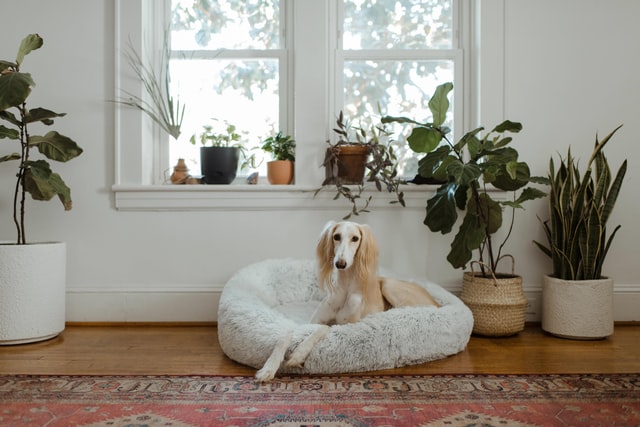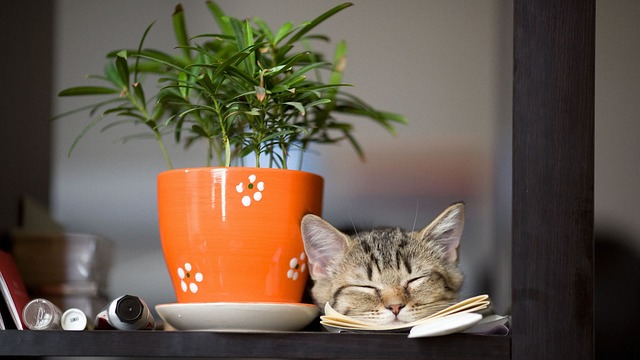Pet Friendly Houseplants (and one’s that aren’t)
Posted: 12/07/2022 | BY: Content Writer | Categories: Cat , Dog , Pet care
If you’re a pet lover, you’re likely also a plant lover. But you may not realize the importance of choosing pet-friendly houseplants that are safe for your fur babies. Certain plants can be toxic to pets when ingested, causing dangerous reactions, like seizures, tremors, or even death. Even the most well-trained pets can take a bite out of your houseplants at some point, so it’s better to be safe than sorry by knowing exactly which plants are pet-friendly and which are not.

The Benefits of having houseplants:
- Cleans and purifies the air in your home for both you and your pet
- Improves environmental wellness
- Reduces stress levels
- Improves your overall mood and sense of well-being
Houseplants that are pet-friendly (and generally safe):
- African Violets
- Baby’s Breath
- Baby Tears
- Bamboo
- Basil Plant
- Bromeliad
- Calathea Orbifolia
- Ferns (*most)
- Friendship Plants
- Gloxinia
- Orchids
- Palms (*most)
- Polka Dot Plant
- Prayer Plant
- Rattlesnake Plant
- Roses
- String of Hearts
- Snake Plant
- Spider Plant
- Succulents (*most)
- Venus Flytrap
- Watermelon Peperomia
- Zinnias
- Any foe plants
Although the above plants are technically safe for dogs and cats, keeping all plants, whether potted or in a vase, out of your pet’s reach is still advisable. This will prevent them from potentially breaking the container, drinking the contaminated water, and/or eating the plants themselves.

Houseplants that are NOT pet-friendly (and potentially dangerous to your pets):
- Aloe: Contains saponins and anthraquinones, both of which have been known to cause lethargy, vomiting, and diarrhea in dogs and cats.
- Amaryllis: A popular holiday plant that contains lycorine, which is known to cause abdominal pain, vomiting, diarrhea, and depression in both cats and dogs. The bulb is the most poisonous part of this plant.
- Azaleas: Contains grayanotoxin, which can cause weakness, diarrhea, and potentially cardiac failure in dogs and cats.
- Birds of Paradise: Contains GI irritants that can cause drowsiness, nausea, and vomiting in cats and dogs.
- Calla Lily: Causes intense oral irritation of the mouth, tongue, and lips in both cats and dogs. You may notice signs of irritation, like excessive drooling, difficulty swallowing, and vomiting. To note: the traditional Lily is nontoxic to dogs but highly toxic to cats and can cause kidney failure if ingested.
- Daffodil: A chemical found in daffodils called lycorine can cause extreme salivation, vomiting, diarrhea, low blood pressure, tremors, and even cardiac arrhythmias in dogs and cats.
- Eucalyptus: Although a trendy plant among humans for its soothing smell, calming effect, and stress-releasing properties, its oil can cause trouble for your pets, such as weakness, depression, salivation, diarrhea, and vomiting.
- Holly: You are more likely to see this plant during the winter holidays. The spikey leaves can upset your pet’s mouth and GI tract. If ingested, the plant can introduce potentially toxic substances to your pet’s system, such as saponins, methylxanthines, and cyanogens. These substances can cause depression, diarrhea, and vomiting in dogs and cats.
- Mums: Another common plant during the holiday season, mums contain sesquiterpene, lactones, pyrethrins, and other potential irritants that can cause vomiting, diarrhea, hypersalivation, incoordination, itchiness, and dermatitis in both dogs and cats.
- Oleanders: A popular plant found to be toxic to many animals. The cardiac glycosides found in oleanders can cause hyperkalemia: when your pets’ potassium levels are too high, which can cause adverse effects on the gastrointestinal system, blood pressure, and neurological system. Oleanders can be toxic to both cats and dogs.
- Poinsettia: Another plant mainly seen during the holidays, is also mildly toxic to cats and dogs and is best avoided when decorating for the holidays. The poinsettia’s milky white sap contains irritating chemicals if ingested by your pets.
- Wisteria: A pretty plant with high levels of lectin and wisterin glycoside, which can cause vomiting, diarrhea, and depression in dogs and cats alike.
How to Know Which of Your Houseplants are Pet-Friendly
The plants listed in this article are not a complete and comprehensive list. If you don’t see one or more of your houseplants mentioned here, there are lots of resources to find out if your houseplants are safe for your pets. One great resource is the ASPCA.
To determine whether a particular plant is a pet-safe investment for your home, the ASPCA has an extensive list of plants to avoid (including both indoor and outdoor plants).
No Plant is Guaranteed to be 100% Pet-Safe
The consumption of any plant material may cause vomiting and gastrointestinal upset for dogs and cats. If you believe your animal is ill or may have ingested a poisonous substance, contact your local veterinarian or the APCC 24-hour emergency poison hotline at 1-888-426-4435.
Have a Plan if Your Pet Gets Ill
Keep your pets increasingly safe from harm by investing in a pet insurance plan! With so many options and plans for every budget, it’s now easier than ever to protect your fur baby (and your wallet) from illness or injury with a pet insurance policy. Some plans start as low as $10 per month and others will cover up to 90% of your vet bills!
Get peace of mind and keep your fur friend safe – Search for a pet insurance plan today.
ASPCA Animal Poison Control Center Phone Number: (888) 426-4435
References:
- ASPCA. “Poisonous Plants: Toxic and Non-Toxic Plants List”. https://www.aspca.org/pet-care/animal-poison-control/toxic-and-non-toxic-plants
- Architect Digest. Via: Kristi Kellogg, Rachel Fletcher, and Audrey Lee. “To The Rescue: 21 Plants That Are Safe for Cats and Dogs”. https://www.architecturaldigest.com/story/pet-friendly-houseplants
The information contained on this blog is intended for informational and educational purposes only and should not be construed as medical advice. It is not a substitute for professional veterinary care. Always consult with your veterinarian before making any changes to your pet's health care or treatment plan.
The authors of this blog are not veterinarians and do not claim to be experts in pet health. The information provided here is based on our own experiences and research, as well as information from reputable sources. However, we cannot guarantee the accuracy or completeness of this information.
We encourage you to do your own research and consult with your veterinarian before making any decisions about your pet's health.
Previous post
The Dangers of Dog Shock CollarsNext post
How To Live With Pet AllergiesCompare top pet insurance providers & plans.
Enter your dog’s age in years and months to calculate their age equivalent to human years.
Calculate your dog’s ageEnter your cat’s age in years and months to calculate their age equivalent to human years.
Calculate your cat’s age